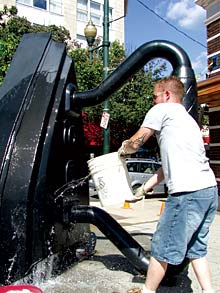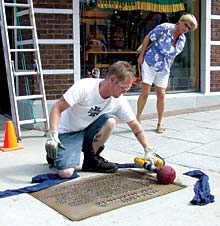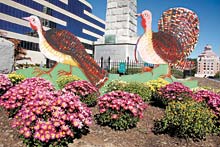“This is a pretty big iron,” Parks and Recreation Department employee Brandon Rogers quips while washing the giant flatiron at the intersection of Wall Street and Battery Park Avenue. “You could do 12 pairs of pants at once with it.”

The massive sculpture, by local artist Reed Todd, is part of station No. 8 on Asheville’s Urban Trail, which uses artwork and explanatory plaques to highlight swatches of the city’s history. A conservation fund supported by a $50,000 annual allotment from the city has enabled Rogers to spend some of his time scrubbing and waxing all the sculptures and their identifying plaques. The goal of the beautification campaign is to do all the sculptures every few months.
But public art hasn’t always been treated so kindly in Asheville. Swannanoa artist Dirck Cruser‘s “Energy Loop” was in danger of being evicted from City/County Plaza when the Pack Square Conservancy launched its makeover of the park. In 2006, Conservancy spokesperson Donna Clark was quoted as saying that the piece, which she referred to as “playground equipment,” was “not suited for the park.” But the resulting outcry from the arts community, coupled with public support via the “Postcards from the Edge” fund-raiser, persuaded the Asheville Arts Council to restore the 1983 sculpture and the Conservancy to include it in the redesigned park.
Meanwhile, sometime between June 29 and July 4, bandits made off with what may have been the city’s most popular installation—a bronze piglet that stood adjacent to the Vance Monument. The pilfered piglet was ripped from its moorings, and the thief (or thieves) also liberated the mother pig, whose substantial mass apparently proved too porky for their poke. After being dragged a mere 5 feet, the larger sculpture was abandoned.
These days, however, things seem to be looking up for the city’s outdoor art. “There are some exciting things happening with the trail now after a fallow period,” Urban Trail Subcommittee member Bill Wescott reports. “The Arts Council has seen pretty lean days, and the city wasn’t paying too much attention, either. When the Pack Square Conservancy started digging in on its park refurbishment, we had to say, ‘Whoa, what about our babies?’—the little girl at the drinking fountain, the turkeys and the pigs—and then the bronze shoat was stolen.”

Today the girl, the sow and other items displaced by infrastructure projects are in safekeeping in a city garage pending reinstallation, and painted representations of the critters now bracket the Vance obelisk.
The Urban Trail began in 1991, when a group of volunteers decided to create a self-guided walking loop through downtown that would tell the story of the city’s past. Various stations along the walk capture the essence of five distinct historical periods. Brochures are widely distributed, and guided tours starting at the Asheville Art Museum are available.
But the long-running project is still a work in progress; last summer, the city issued a call for proposals from artists for station No. 1, the final missing piece. Planners had saved the first for last, it seems, and when the winning entry is installed in front of Pack Place, the controversial electric sign that now occupies the spot will be history.
Seven artists submitted proposals in August, says Wescott, and the committee has winnowed those to three finalists, whose formal sketches and maquettes will be received by year’s end. “The winner will be chosen early in 2008, and installation should be complete by the end of next year,” he predicts.
This little piggy went to market

Bronze is durable but dear. It currently fetches about $2 a pound on the scrap market—which may well be where our missing piglet wound up—and sculpture thefts, like metal prices, have risen nationwide. Of course, that’s nothing compared to what the actual statues were worth. Station No. 2 on the Urban Trail included two turkeys, the aforementioned pigs, and footprints suggesting human and animal traffic, all of which cost $59,000 in 2001. The money came from a $38,300 Janirve Foundation grant and private donations.
Perhaps that incident gave the city an increased appreciation for its treasures. In any case, Rogers now periodically makes his way along the trail, scrubbing and polishing as he goes. That gives him a close-up view of each piece, including any damage they’ve sustained. “In front of the Civic Center, there’s a man playing a fiddle, and the bow strings are broken,” he notes. “Also, there’s a plaque missing across the street from the Civic Center.” And while most of the artwork is at street level, Rogers says he hasn’t yet figured out how he’ll clean the bronze eagle atop a pole at the intersection of Eagle Street and Biltmore Avenue. “I may get a bucket truck from the city, but I don’t know where I’d park it. Eagle Street is pretty narrow. I may have to reach it with a long-handled brush from the parking deck.”
Another local artist, Martha Peiser, has been enlisted to restore the Italian-made mosaic plaque formerly embedded in the sidewalk adjacent to the Wachovia Bank Building, bordering Pritchard Park. The plaque, which directs attention to architect Douglas Ellington’s masterly S&W Cafeteria building across the street, was damaged by foot traffic and will be reinstalled on a wall to reduce future wear and tear.
Funding for station No. 1 will come from the Vetust Study Club, says Wescott. Established in 1945, the group researches local history and funds preservation projects with money raised via an annual antiques auction.
Even the case of the missing piglet has a kind of silver lining, says Wescott. “We’ve lately started doing things we’ve been working toward for 10 years. Part of the conservation effort included an appraisal of the city’s art, which is now included in the city’s insurance plan. The thing that kicked that off was the stolen shoat.”
Meanwhile, Rogers collects his brushes and buffer and heads for Broadway Street, where he has a soapy date with a little boy on stilts.



Before you comment
The comments section is here to provide a platform for civil dialogue on the issues we face together as a local community. Xpress is committed to offering this platform for all voices, but when the tone of the discussion gets nasty or strays off topic, we believe many people choose not to participate. Xpress editors are determined to moderate comments to ensure a constructive interchange is maintained. All comments judged not to be in keeping with the spirit of civil discourse will be removed and repeat violators will be banned. See here for our terms of service. Thank you for being part of this effort to promote respectful discussion.